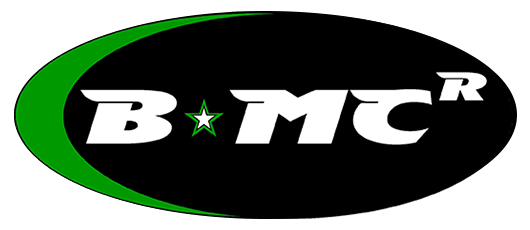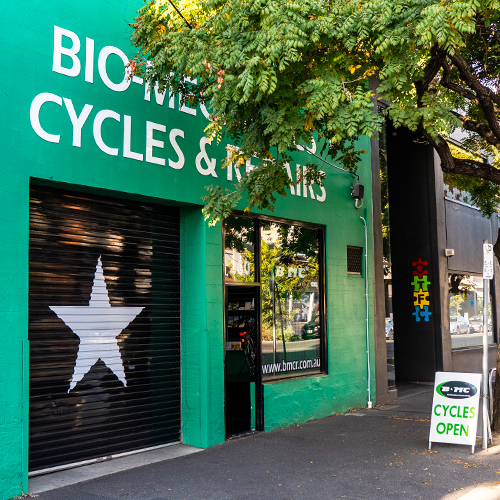Why is your bike making a weird noise? [UPDATED NOV 2022]


Why your bike may be squeaking, ticking, grinding or crunching
What’s one of the fastest ways to turn a lovely bike ride into an eye-twitchingly irritating excursion?
We’ll give you a hint.
Tick.
Tick.
Tick.
Click.
Squeak.
Clunk.
That noise. That noise. It’s driving you – and anyone you’re riding with – nuts.
Not only that, but your bike wasn’t making that noise last time you rode it. And sometimes when you try to work out what the noise actually is, it suddenly stops, only to unexpectedly return later like a drunk dinner guest who’s forgotten their house keys and then won’t leave.
So why is your bike making a weird noise? And is it a simple fix, or potentially the sign of a bigger problem?
The first thing to do is determine what the sound is, if it’s emanating from any particular part of the bike, and if there are any things happening in conjunction which may be extra clues.
Here are the steps you need to take to try and find the culprit.

What kind of noise is it?
Is your bike clicking when you pedal? If so, is it a single click or a series of clicks?
Is your bike making a groaning or clunking noise instead, or is it more of a creak?
Where is it coming from?
One thing that makes finding noises on modern bikes tricky is the fact that large-diameter frame tubing tends to resonate noise, making it difficult to pinpoint the source. What appears to be coming from one part of the bike can actually be coming from somewhere else. It’s kind of like an audio illusion. (Aullusion? Is that a thing?)
This is where having a second person on hand is extremely helpful. While riding, see if your friend can hear more accurately which part of the bike the sound is coming from. (This is arguably easier if you’re able to create the noise on the flat, but give it a shot anyway.)

When is the noise happening?
Is your bike only making noise when you’re pedalling?
Does it change if you’re on the saddle or off it? Test this by pedalling both seated and standing.
Can you do it while you’re riding along the flats or is your bike only creaking/clicking when you’re cranking up a climb? Can you recreate the noise by dragging your brakes on the flat to obtain enough load on the pedals?
If your bike is noisy when you’re pedalling, does the noise happen at the same point in the pedal stroke or is it random? Is it only on one side, or do both cranks create the noise (so two clicks per revolution)?
Does it only happen in certain gears? Ride in different combinations while keeping the load constant and see if the noise continues.
Once you have this information, it will make narrowing down the suspect a lot easier.

What might be causing it?
Let’s look at the most likely culprit for each of these scenarios.
Your chain
Chains can easily be a source of clicks, especially if they’re stiff.
Chains lose flexibility for three reasons:
- They’re gummed up with lube.
- Conversely, there’s no lube and they’re completely dry.
- They’re freshly waxed.
You can confirm the problem is a stiff chain if the noise is happening when you’re cross-chaining (e.g. you’re riding in the small chain ring at the front and the smallest physical cogs at the back). In this position, the chain is being dragged at an angle, which it doesn’t really like if it’s not lubricated enough or it can’t flex because it’s filled with wax.
Test this out by switching gears at the back so the chain is moving towards the spokes. Does the noise stop? Then that’s your problem. Revisit your lube/wax situation.
If the click is happening every 2-3 pedal revolutions, then it could be that you have a damaged link.
If it’s multiple times per pedal revolution, it could be a bent tooth on the cassette (rear cogs). A single click per revolution could mean that there's a damaged tooth on a chain ring (front cogs). If your gears slip when the noise is happening, this can be another clue.
Check the chain and cogs carefully to see if you can spot the problem area. Some teeth can be bent back into shape, but if you’re not sure, make a time to get it checked out.

Your quick-release skewers or through-axles
When the noise is occurring, are your brakes also rubbing? (On a rim-brake bike, this would mean your pads are contacting the rim. For disc brakes, the rotor will be rubbing the brake pads.)
If this is happening, your quick-release skewers may not be tight enough. The skewer is the only thing holding the wheel in, so if they’re a bit loose, the wheel may be moving in the frame as you pedal, hence the click/tick.
Try tightening your skewers and see if the noise stops after this. Remember: the skewer has to be tight enough that you need to use a bit of force to close the lever, such as leveraging your fingers against your spokes. If you can easily close it, it’s too loose.
Some skewer designs also don’t have the correct level of clamping force, even if they come with expensive wheels. (It’s one of the weird things about the industry; so much effort has gone into the design of the wheel, but the thing that actually stops it falling out of the frame is apparently an afterthought.)
Our recommendation here is a basic set of Shimano skewers: they’re inexpensive and tend to give the best result. Give them a try and see if that solves the problem. (And, yes, we do have them in stock, thanks for asking.)
If your bike has through-axles, it’s pretty much the same principle: make sure they’re tight and are holding your wheels securely in the frame and forks.
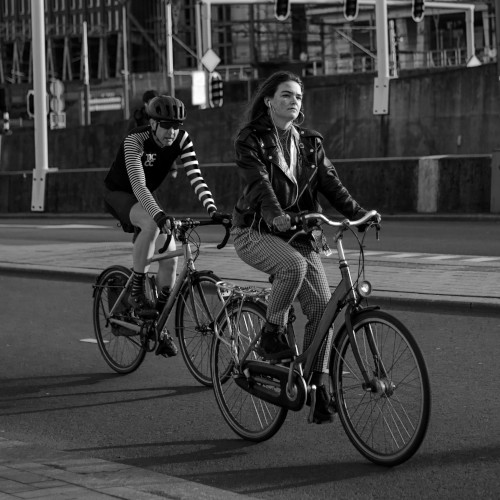
YOUR BEARINGS
As bearings wear with use, their tolerances increase (which means they start to get sloppy in the hub or frame). This can sometimes result in a creaky ride.
Bottom bracket bearings will usually tell you when they’re worn – you’ll feel a grinding or notchy sensation when you pedal. Other telltale signs include any sloppiness or play in the cranks. If you can wiggle them, that’s a bad sign.
To test your hub bearings, take your wheel out and spin the axle. Does it feel rough or crunchy, rather than nice and smooth? Is there any side-to-side movement or play in it?
Even if your bearings aren’t the source of the noise you're chasing, if they’re rough or loose, get them serviced so you’re not riding on loose bits of metal which can break up and chew out your hubs/frame.

YOUR PIVOTS
If you have a dual-suspension mountain bike that’s making noises, try riding it on the road. Does the noise go away? If so, it may be pivot-related.
Check your pivot bearings for tightness. If everything’s done up correctly but it’s still making a clicking sound, you’ll want to get them checked out. (Pivot bearings are a lot harder to service at home; they require quite a few specific tools – the bearings themselves notwithstanding – and it’s very easy to get something catastrophically stuck.)
YOUR HANDLEBARS
Handlebars can make ticks, clicks or creaks when the joint between the bars and the headstem is dry. This is an area we look after in a general service as certain components need particular greases or pastes to ensure they don’t click together.
Handlebars can also click when they’re (eek!) cracked.
To check them out, take off the headstem face plate and inspect the bars thoroughly, especially at the clamping area. Also, check the areas where the gear and brake levers are mounted. Make sure to look for any lines or crush marks. If you spot a problem, ditch those bars for a new set. This is a component you definitely don’t want snapping out from under you on a descent.
When you’re refitting your bars, add the appropriate compound to stop the bars and stem clicking together, and make sure that all bolts are done up correctly. (More on that in a moment.)
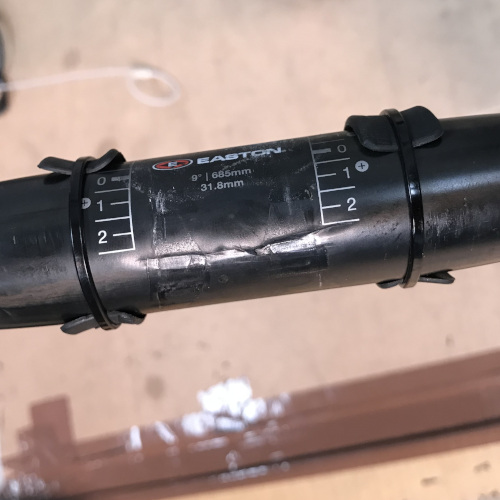
YOUR SADDLE
Is the noise only happening when you’re seated, and goes away when you’re pedalling out of the saddle? Then the saddle itself can be the cause. Like any bicycle component, saddles wear out with use; they’re doing a lot of heavy lifting, even if you’re not very heavy.
The first place to check is the underside of the saddle. Try flexing it, and don’t be too surprised if you see a crack open up. (Hey, at least you know now.)
Saddle rails can also click if they’re broken or separating from the saddle body.
In either case, it’s time for a new seat.

YOUR PEDALS
If you’ve isolated the noise as potentially coming from your pedals, this is a pretty easy one to test if you have a second set of pedals on hand. Just swap them out and go for a ride to see if the noise is gone. Ta-da!
As with most things, the clicking here can be related to a dry joint. If you’re using clip-in pedals, try spraying the area that contacts the cleats with WD40 and see if that helps.

WATER CONTAMINATION
Have you washed your bike recently? Enthusiastic cleaning (especially if you’re using a high-pressure sprayer) can force moisture past seals and also into components. Even if you’ve tried to avoid this, it’s possible that there’s water inside the frame, which can cause unusual noises.
(If you’ve been riding through a lot of wet weather, this can also result in a water-logged frame, so don’t be too quick to blame yourself.)
To test the theory, remove the seatpost and leave the bike upside down to dry out. Once you’re back on the bike, if the noise has gone, you’ll know what the culprit was.
Not sure how to avoid getting water in your frame? Here’s a quick refresher on the best way to look after it.
YOUR SUSPENSION FORKS
This is a difficult one.
If the click is coming from the junction of the steerer tube and fork uppers, then unfortunately there’s nothing that can be done to fix it -- it’s not a serviceable area. The click results from the way that the forks are made at the factory, and it’s a known issue with certain brands.
While we’d say that the only solution is new uppers or a new fork, the bad news is that there’s also no guarantee that the new ones won’t click as well.
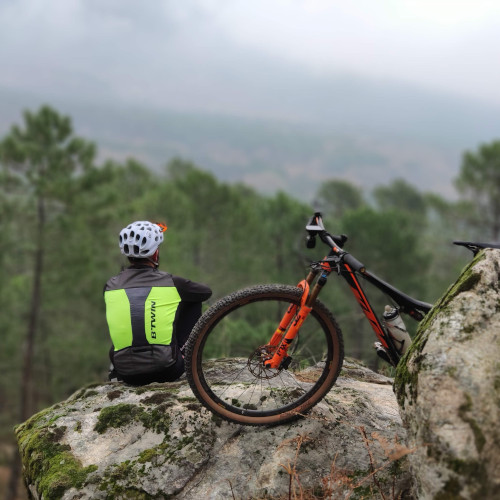
YOUR REAR DERAILLEUR HANGER
A bent derailleur hanger means that your gears won’t be behaving themselves, and sometimes that can show up as noises such as the chain rubbing on the next cog.
If your noise is metallic and sounds like ting ting ting ting, though, there’s a good chance that your hanger is so bent that the rear derailleur is brushing against the spokes of the wheel as you’re riding. If you ignore this, it can result in the derailleur actually going into the spokes, which can rip the derailleur off, tear the spokes out of the wheel, and send you to hospital.
Stop riding your bike until you can get the hanger sorted out.
YOUR WATER BOTTLE BOSSES
An obscure one, but a source of noises which has frustrated riders and mechanics alike for eons, primarily because most people don’t think to look at this area for the problem, and instead spend hours chasing a noise they will never find.
Check that the bosses are still tight in the frame and are not corroded. As a test, try putting a piece of tape between the frame and your bottle cage. If the noise disappears, that's your answer.

YOUR FRAME
Have you had an accident or crash? A source of clicking can sometimes be a cracked frame.
Remove the wheels and inspect your frame, going methodically from front to back.
You’ll want to take your time with this as some cracks are hard to discover. Use a small torch, and pay particular attention to the frame joints and drop-outs. Don’t forget to check your forks, either.
If you’ve got a carbon frame and come across a suspect area, give it a squeeze. Carbon is not supposed to feel squishy or soft, so if yours is, don’t ride it. (Fortunately it can usually be repaired.)
IF YOU STILL CAN’T FIND OUT WHAT THE PROBLEM IS
At this point, you’ll want to bring your bike in. Noises can be notoriously hard to find because they can be created by so many different areas on a bike, and many of them are hard to test. Even a worn drive train can create all sorts of weird sounds.
Going through the above areas in a process of elimination, however, will really help narrow down the issue, especially if you can accurately describe the noise and the situation in which it occurs. Better yet, get a recording of it, or even a video. (Again, this is far easier to do if you’re riding with a friend.)
This kind of research not only reduces wasted time looking for causes (and therefore makes your repair bill cheaper) but also gives us some handy guidelines to work to.
Bicycles aren’t supposed to be noisy, so something’s not right, and it’s far better to find out what it is than keep riding on what could turn out to be a catastrophic problem.
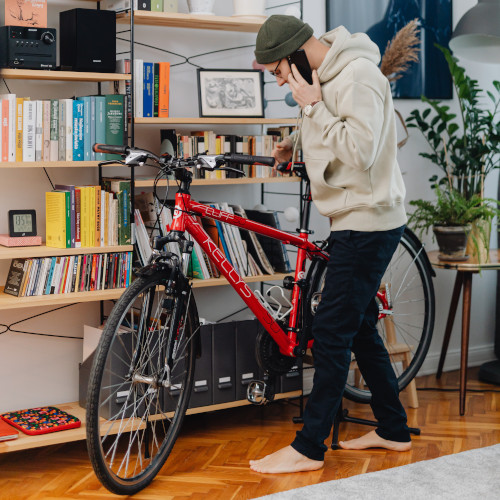
A WORD ON CARBON BITS
Oh, that note about tightening bolts?
We see numerous home mechanics who have crushed an expensive set of bars or seat post and have reported that they were only following the recommended Nm. The problem is that when you see a torque rating on an item (for example a set of handlebars marked x-x Nm), the highest rating isn’t actually the recommended rating – it’s the maximum. (Yup, it's a bit misleading.)
Start from at least 20% below the highest number printed on the component and test to see if it stays put. If it doesn’t, go up half a Newton-metre from there. Don’t just crank it immediately to the max.
You’re welcome!
Being driven mad by a mystery noise? We can fix that.
